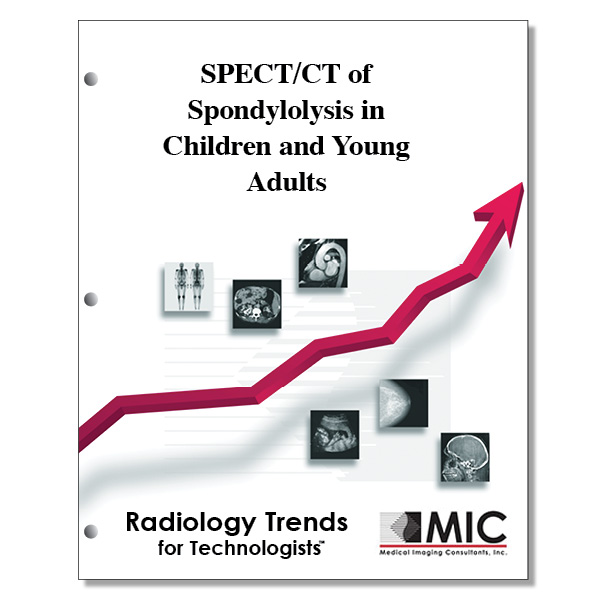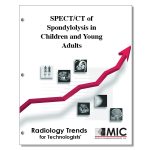

SPECT/CT of Spondylolysis in Children and Young Adults
A review of the SPECT/CT assessment of spondylolysis and other causes of low back pain in children and young adults that can be identified at SPECT/CT.
Course ID: Q00493 Category: Radiology Trends for Technologists Modalities: CT, Nuclear Medicine2.25 |
Satisfaction Guarantee |
$24.00
- Targeted CE
- Outline
- Objectives
Targeted CE per ARRT’s Discipline, Category, and Subcategory classification for enrollments starting after February 14, 2023:
[Note: Discipline-specific Targeted CE credits may be less than the total Category A credits approved for this course.]
Computed Tomography: 0.50
Procedures: 0.50
Head, Spine, and Musculoskeletal: 0.50
Magnetic Resonance Imaging: 0.50
Procedures: 0.50
Neurological: 0.50
Nuclear Medicine Technology: 2.25
Procedures: 2.25
Other Imaging Procedures: 2.25
Radiography: 0.50
Procedures: 0.50
Head, Spine and Pelvis Procedures: 0.50
Registered Radiologist Assistant: 2.25
Procedures: 2.25
Musculoskeletal and Endocrine Sections: 2.25
Outline
- Introduction
- Low Back Pain in Children and Adolescents
- Causes
- Workup
- Anterior and Posterior Planar Whole-Body Images
- Planar Spot Images (Optional
- SPECT Images
- Imaging Findings
- Spondylolysis
- Posterior Element Abnormalities
- Lumbar Interspinous Bursitis
- Spinous Process Avulsion
- Facet Hypertrophy
- Endplate and Disk Abnormalities
- Endplate-Apophyseal Injuries
- Degenerative Disk Disease
- Endplate Compression Fractures
- Transverse Process Abnormalities
- Persistent Transverse Process Ossification Center
- Transverse Process Fractures
- Sacroiliac Abnormalities
- Transitional Vertebrae (Bertolotti Syndrome
- Sacral Stress Fractures
- Sacroiliac Joint Syndrome
- Other Abnormalities
- Diskitis and Osteomyelitis
- Chronic Recurrent Multifocal Osteomyelitis
- Benign Tumors
- Malignant Tumors
- Conclusion
Objectives
Upon completion of this course, students will:
- identify the imaging modality that is suited for assessment of low back pain in children and adults
- be familiar with the most common structural cause of lower back pain in pediatric and adolescent populations
- be familiar with the number of ossification centers in the vertebra
- be familiar with more urgent imaging assessment when neurological symptoms are present
- be familiar with the radiopharmaceutical used for bone scintigraphy
- be familiar with accumulation of radiotracer when performing bone scintigraphy
- be able to identify the collimator recommended for performing whole body bone scintigraphy
- be familiar with the technique used to collect planar spot images during bone scintigraphy
- be familiar with the advantages of SPECT/CT over the use of SPECT alone
- be familiar with the conditions for using CT with SPECT imaging
- be familiar with the radiation dose for imaging the pediatric spine
- be familiar with abnormalities of the pars interarticularis
- be familiar with the limitations of using radiography for diagnosing spondylolysis
- be familiar with the radiotracer patterns demonstrated when nonunion occurs in the pars interarticularis
- be familiar with Baastrup disease
- be familiar with a benign tumor that can mimic facet hypertrophy on SPECT/CT
- be able to identify which imaging modalities can help differentiate facet hypertrophy from osteochondroma
- be familiar with common entities that result in endplate uptake at SPECT
- be familiar with Schmorl nodes and limbus vertebra
- be familiar with the location of osteoporotic compression fractures in the spine
- be familiar with the entities causing asymmetrically increased transverse process uptake at SPECT
- be able to identify the vertebral fractures demonstrated in the endplates at SPECT
- be familiar with the most common level of the lumbar spine for transverse process fractures
- be familiar with common entities that result in increased or asymmetric sacroiliac uptake at SPECT
- be familiar with the name of the low back pain associated with transitional vertebra
- be able to identify transverse vertebral fractures on SPECT images
- be familiar with the radiotracer uptake when sacral stress fractures present at SPECT imaging
- be familiar with the causes of sacroiliac joint pain
- be familiar with the ability of skeletal scintigraphy to diagnose sacroiliac joint syndrome
- be familiar with the limitations of radiographic procedures to diagnose acute sacroiliac joint abnormalities
- be able to identify sacral stress fractures on SPECT images
- be familiar with the benign bone tumors that are related to abnormal formation of osteoid or woven bone
- be familiar with the characteristics of osteoid osteomas
- be familiar with the malignant primary tumors of the bone
- be familiar with the CT appearance of malignant primary bone tumors
